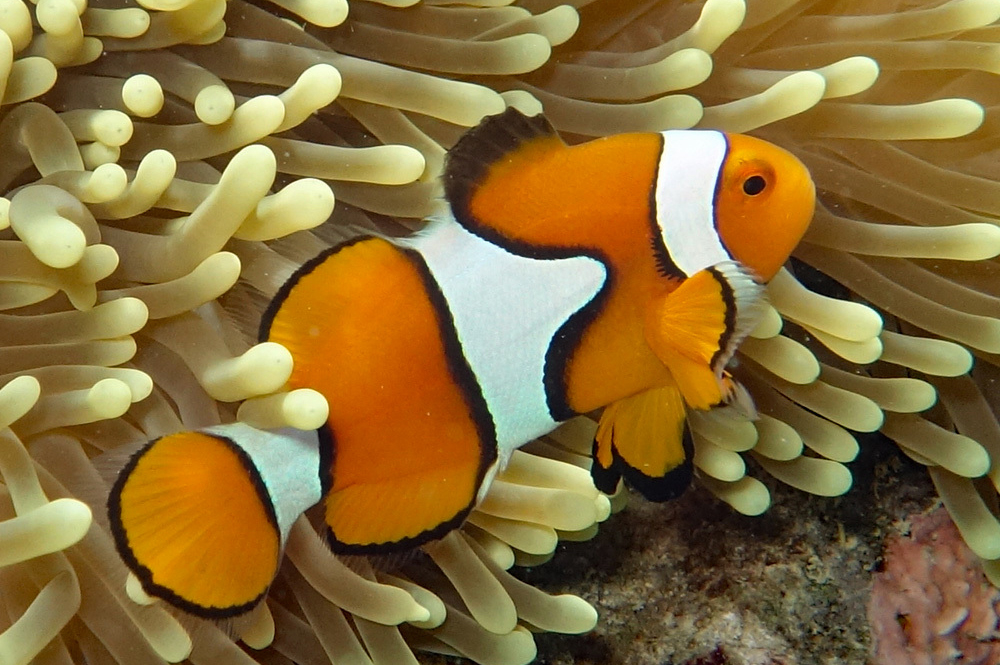Eastern Clown Anemonefish, Amphiprion percula (Lacépède 1802)

An Eastern Clown Anemonefish, Amphiprion percula, at Lizard Island, Great Barrier Reef, Queensland, March 2014. Source: Lyle Vail via Anne Hoggett / iNaturalist.org. License: CC By Attribution-NonCommercial
Eastern Clown Anemonefish, Amphiprion percula (Lacépède 1802)
More Info
|
Distribution |
Great Barrier Reef, Queensland, from the Torres Strait to the Capricorn Group. Elsewhere the species occurs in the west Pacific. On outer reefs, the species usually associates with Heteractis crispa and H. magnifica, while on sheltered inshore reefs it lives with Stichodactyla gigantea. |
|
Biology |
Anemone fishes live in small social groups in a commensal relationship with host anemones, and are protandrous hermaphrodites, with the ability to change sex from male to female. They form monogamous pairs and The groups include a monogamous pair of sexually functional adults and from zero to several sexually non-functional subadults and juveniles. Individuals first mature as functional males with gonads comprising both ovarian tissue with immature oocytes and testicular tissue with active spermatogenesis. During the functional female phase however, only ovarian tissue is present. Sex change is socially controlled by a strict dominance hierarchy, with the single female as the largest fish in the group. If the female dies, the largest male changes sex to become the breeding female, while the largest non-breeder becomes the breeding male. During the breeding season, males select nesting sites close to the host anemone. They clear the site of any algae and debris, often aided by the female, and she lays her eggs onto this surface. |
|
Remarks |
Anemonefish and their anemone hosts live in a mutualistic partnership - the anemone protects the clownfish against predators, and the fish provides the anemone's zooxanthellae algae with excreted nutrients. |
|
Etymology |
The specific name is from the Latin perca (= perch) and –ula (= little), a manuscript name originally from Commerçon. |
|
Species Citation |
Lutjanus percula Lacépède, 1802, Histoire Naturelle des Poissons 4: 194, 239. Type locality: Port Praslin, New Ireland, Bismarck Archipelago. |
|
Author |
Bray, D.J. 2025 |
|
Resources |
Eastern Clown Anemonefish, Amphiprion percula (Lacépède 1802)
References
Allen, G.R. 1972. Anemonefishes, their Classification and Biology. Neptune CityNew Jersey : T.F.H. Publications 288 pp., 140 figs.
Allen, G.R. 1975. The Anemone Fishes. Their Classification and Biology. Neptune City, New Jersey : T.F.H. Publications 2, 351 pp.
Allen, G.R. 1975. Damselfishes of the South Seas. New Jersey : T.F.H. Publications 237 pp. 251 figs.
Allen, G.R. 1991. Damselfishes of the World. Melle, Germany : Mergus Verlag 271 pp.
Allen, G.R. & Erdmann, M.V. 2012. Reef fishes of the East Indies. Perth : Tropical Reef Research 3 vols, 1260 pp.
Buston, P. 2003. Size and growth modification in clownfish. Nature 424: 145-146.
Buston, P.M. 2003. Forcible eviction and prevention of recruitment in the clown anemonefish. Behavioral Ecology 14(4): 576–582.
Buston, P.M. 2003. Mortality is associated with social rank in the clown anemonefish (Amphiprion percula). Marine Biology 143(4): 811–815.
Buston, P. 2004. Does the presence of non-breeders enhance the fitness of breeders? An experimental analysis in the clown anemonefish Amphiprion percula. Behavioral Ecology and Sociobiology 57: 23–31. https://doi.org/10.1007/s00265-004-0833-2
Buston, P.M. & Garcia, M.B. 2006. An extraordinary life span estimate for the clown anemonefish Amphiprion percula. Journal of Fish Biology 70: 1710–1719. https://doi.org/10.1111/j.1095-8649.2007.01445.x
Elliot, J.K., Elliot, J.M. & Mariscal, R.N. 1995. Host selection, location, and association behaviors of anemonefishes in field settlement experiments. Marine Biology 122(3): 377–389. https://doi.org/10.1007/BF00350870
Elliot, J.K. & Mariscal, R. 2001. Coexistance of nine anemonefish species: differential host and habitat utilization, size and recruitment. Marine Biology 138: 23–36. https://doi.org/10.1007/s002270000441
Fautin, D.G. 1992. Anemonefish Recruitment: The Roles of Order and Chance. Symbiosis 14: 143–160.
Fautin, D.G. & Allen, G.R. 1992. Field guide to anemone fishes and their host sea anemones. Perth : Western Australian Museum 160 pp.
Grant, E.M. 1975. Guide to Fishes. Brisbane : Queensland Government, Co-ordinator General’s Department 640 pp.
Grant, E.M. 1991. Fishes of Australia. Brisbane : EM Grant Pty Ltd 480 pp.
Jenkins, A., Allen, G., Myers, R., Yeeting, B. & Carpenter, K.E. 2017. Amphiprion percula. The IUCN Red List of Threatened Species 2017: e.T188372A1865631. https://dx.doi.org/10.2305/IUCN.UK.2017-2.RLTS.T188372A1865631.en. Accessed on 18 March 2025.
Lacépède, B.G. 1802. Histoire Naturelle des Poissons. Paris : chez Plassan Vol. 4 728 pp. 16 pls. See ref at BHL
Mebs, D. 1994. Anemonefish Symbiosis: Vulnerability and Resistance of Fish to the Toxin of the Sea Anemone. Toxicon 32(9): 1059–1068. https://doi.oeg/10.1016/0041-0101(94)90390-5
Randall, J.E., Allen, G.R. & Steene, R. 1990. Fishes of the Great Barrier Reef and Coral Sea. Bathurst : Crawford House Press 507 pp. figs.
Salles, O.C., Maynard, J.A., Joannides, M., et al. 2015 Coral reef fish populations can persist without immigration. Proceedings of the Royal Society B 282: 20151311. http://dx.doi.org/10.1098/rspb.2015.1311
Thresher, R.E., Colin, P.L. & Bell, L.J. 1989. Planktonic duration, distribution and population structure of western and central Pacific damselfishes (Pomacentridae). Copeia 1989(2): 420-434.
Whitley, G.P. 1929. Some fishes of the order Amphiprioniformes. Memoirs of the Queensland Museum 9(3): 207-246 figs 1-4 pls 27-28 (as Actinicola percula)




